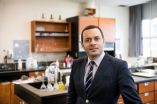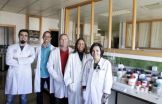(Press-News.org) This news release is available in French.
We know that babies and young children often put non-food items in their mouths, a behaviour that occasionally leads to swallowing of foreign objects. Metallic toys and low-cost jewelry often contain toxic substances such as lead and cadmium. Do these objects present a health risk for young children?
To answer this question, Gérald J. Zagury, a professor in the Department of Civil, Geological and Mining Engineering at Polytechnique Montréal, and Mert Guney, a former doctoral student under Professor Zagury's supervision, examined metals contamination in a selection of 72 toys and jewelry items purchased on the North American market. They then conducted in vitro tests on 24 samples by recreating the biochemical conditions of the gastrointestinal system in the laboratory in order to get an accurate answer.
"We observed that cadmium and lead contamination, both very toxic metals, are a major problem, especially when it comes to metallic jewelry and toys. Copper, nickel, arsenic and antimony were also present in some samples," explains Professor Zagury. In-depth tests showed that the metals can be mobilized into the digestive fluids once contaminated items are ingested. The researchers also observed that the mobilized quantities of cadmium, lead and nickel from some samples exceeded the safety threshold levels that a child can be exposed to without suffering acute harmful effects (abdominal pain, nausea, vomiting and diarrhea) or variable chronic effects depending on the contaminant. It must be noted that chronic ingestion of lead and cadmium can have irreversible effects on a child's intellectual development.
INFORMATION:
The results presented in this study are part of Mert Guney's doctoral thesis and were recently published in the American Chemical Society's (ACS) reputed scientific journal, Environmental Science & Technology. The article was selected to appear in ACS' Editors' Choice; the open-access article can be read at
http://pubs.acs.org/doi/abs/10.1021/es4036122.
The study was made possible thanks to the financial support of the Natural Sciences and Engineering Research Council of Canada (CRSNG).
Reference: Guney M, Zagury GJ (2014). Bioaccessibility of As, Cd, Cu, Ni, Pb, and Sb in Toys and Low-Cost Jewelry. Environmental Science & Technology, published online, DOI: 10.1021/es4036122. 48 (2), pp 1238–1246.
About Polytechnique Montréal
Founded in 1873, Polytechnique Montréal is one of Canada's leading engineering teaching and research institutions. It is the largest engineering university in Québec for the size of its graduate student body and the scope of its research activities. With over 41,400 graduates, Polytechnique Montréal has educated nearly one-quarter of the current members of the Ordre des ingénieurs du Québec. Polytechnique provides training in 15 engineering specialties, employs 248 professors and has more than 7,500 students. It has an annual operating budget of over $200 million, including an $82-million research budget.
Some metallic toys and low-cost jewelry present health risks for young children
Polytechnique Montréal study
2014-03-05
ELSE PRESS RELEASES FROM THIS DATE:
Half of pregnant women are passive smokers, due above all to their partners
2014-03-05
As shown in a study carried out by researchers at 13 research centres in Asturias, Gipuzkoa, Sabadell and Valencia, over half of non-smoking pregnant women, 55%, are passive smokers. These women are under the effect of tobacco smoke to a considerable extent because a member of the household, their partner in particular, smokes at home. The result of the study has been published in the journal Science of the Total Environment.
Within the INMA project that studies childhood and the environment, research has been carried out into the extent to which non-smoking pregnant ...
Sulphur haunts the ghost wreck
2014-03-05
Scientists from the same team have previously reported large amounts of sulphur and iron accumulation in the warship Vasa. In that study, the scientists found an outbreak of acidity and sulphate salts on the surface of the hull and other wooden objects.
'This is the result of biological and chemical processes that occur naturally in low-oxygen waters and in sediments,' says Yvonne Fors from the Department of Conservation at the University of Gothenburg and one of the scientists behind the article.
However, even if sulphur and iron accumulation is commonly occurring ...
Plumes in the sleeping avian brain
2014-03-05
This news release is available in German.
When we drift into deep slow-wave sleep (SWS), waves of neuronal activity wash across our neocortex. Birds also engage in SWS, but they lack this particular brain structure. Researchers from the Max Planck Institute for Ornithology in Seewiesen, Germany together with colleagues from the Netherlands and Australia have gained deeper insight into the sleeping avian brain. They found complex 3D plumes of brain activity propagating through the brain that clearly differed from the two-dimensional activity found in mammals. These ...
New technique allows frequent water quality monitoring for suite of pollutants
2014-03-05
Researchers from North Carolina State University have developed a new technique that uses existing technology to allow researchers and natural resource managers to collect significantly more information on water quality to better inform policy decisions.
"Right now, incomplete or infrequent water quality data can give people an inaccurate picture of what's happening – and making decisions based on inaccurate data can be risky," says Dr. François Birgand, an assistant professor of biological and agricultural engineering at NC State and co-author of a paper describing the ...
Copied from nature: Detecting software errors via genetic algorithms
2014-03-05
This news release is available in German.
According to a current study from the University of Cambridge, software developers are spending about the half of their time on detecting errors and resolving them. Projected onto the global software industry, according to the study, this would amount to a bill of about 312 billion US dollars every year. "Of course, automated testing is cheaper", explains Andreas Zeller, professor of Software Engineering at Saarland University, as you could run a program a thousand times without incurring any charges. "But where do these ...
New findings on neurogenesis in the spinal cord
2014-03-05
Research from Karolinska Institutet in Sweden suggests that the expression of the so called MYC gene is important and necessary for neurogenesis in the spinal cord. The findings are being published in the journal EMBO Reports.
The MYC gene encodes the protein with the same name, and has an important role in many cellular processes such as proliferation, metabolism, cell death and the potential of differentiation from immature stem cell s to different types of specialized cells . Importantly it is also one of the most frequently activated genes in human cancer.
Previously ...
Barbie could dampen a young girl's career dreams
2014-03-05
Although the marketing slogan suggests that Barbie can "Be Anything," girls who play with this extremely popular doll see fewer career options available to themselves compared to boys. So say Aurora Sherman of Oregon State University and Eileen Zurbriggen of the University of California, Santa Cruz, who conducted one of the first experiments on how playing with fashion dolls influences girls' perceptions about their future occupational options. The findings, which the psychologists describe as "sobering," are published in Springer's journal Sex Roles.
Sherman and Zurbriggen ...
Technique patented that opens the door to the development of new drugs against osteoporosis
2014-03-05
This news release is available in Spanish.
Scientists from the University of Granada (UGR) have opened the door to the development of new drugs against osteoporosis, one of the most common chronic illnesses in the world, especially among women 65 or over.
The researchers, from the University of Granada's Department of Physio-Chemistry, have patented a new methodology that allows specialists to measure – none-invasively and in real time – the concentration of phosphate ions inside living cells. The scientific importance of measuring phosphate ions is based precisely ...
Banana plant fights off crop's invisible nemesis: Roundworms
2014-03-05
The banana variety Yangambi km5 produces toxic substances that kill the nematode Radopholus similis, a roundworm that infects the root tissue of banana plants – to the frustration of farmers worldwide. The finding bodes well for the Grande Naine, the export banana par excellence, which is very susceptible to the roundworms.
The parasitic nematode Radopholus similis is the invisible nemesis of the banana plant, says Professor Dirk De Waele (Laboratory for Tropical Crop Improvement, KU Leuven), a co-author of the study: "This roundworm infects banana crops worldwide. The ...
Patients' stories used to improve care on wards
2014-03-05
A research project led by Oxford University is showing how patient experiences can be used to improve healthcare – not through targets and surveys, but by getting doctors, nurses and patients talking together about care on the ward.
The new approach has been used in pilot projects at two UK hospital trusts – Royal Brompton & Harefield NHS Foundation Trust in London and the Royal Berkshire in Reading. Videos of patients talking about care they received at various hospitals are used to trigger a discussion between NHS staff, managers, patients and family members about the ...
LAST 30 PRESS RELEASES:
Exploring how the visual system recovers following injury
Support for parents with infants at pediatric check-ups leads to better reading and math skills in elementary school
Kids’ behavioral health is a growing share of family health costs
Day & night: Cancer disrupts the brain’s natural rhythm
COVID-19 vaccination significantly reduces risk to pregnant women and baby
The role of vaccination in maternal and perinatal outcomes associated with COVID-19 in pregnancy
Mayo Clinic smartwatch system helps parents shorten and defuse children's severe tantrums early
Behavioral health spending spikes to 40% of all children’s health expenditures, nearly doubling in a decade
Digital cognitive behavioral treatment for generalized anxiety disorder
Expenditures for pediatric behavioral health care over time and estimated family financial burden
Air conditioning in nursing homes and mortality during extreme heat
The Alps to lose a record number of glaciers in the next decade
What makes a good proton conductor?
New science reporting guide published for journalists in Bulgaria
New international study reveals major survival gaps among children with cancer
New science reporting guide published for journalists in Turkey
Scientists develop a smarter mRNA therapy that knows which cells to target
Neuroanatomy-informed brain–machine hybrid intelligence for robust acoustic target detection
Eight SwRI hydrogen projects funded by ENERGYWERX
The Lundquist Institute and its start-up company Vitalex Biosciences Announces Strategic Advancement of Second-Generation fungal Vaccine VXV-01 through Phase 1 Trials under $40 Million Competitive Con
Fine particles in pollution are associated with early signs of autoimmune disease
Review article | Towards a Global Ground-Based Earth Observatory (GGBEO): Leveraging existing systems and networks
Penn and UMich create world’s smallest programmable, autonomous robots
Cleveland researchers launch first major study to address ‘hidden performance killer’ in athletes
To connect across politics, try saying what you oppose
Modulating key interaction prevents virus from entering cells
Project explores barriers to NHS career progression facing international medical graduates
Jeonbuk National University researchers explore the impact of different seasonings on the flavor perception of Doenjang soup
Two Keck Medicine of USC Hospitals named Leapfrog Top Teaching Hospitals
World-first discovery uncovers how glioblastoma tumours dodge chemotherapy, potentially opening the door to new treatments
[Press-News.org] Some metallic toys and low-cost jewelry present health risks for young childrenPolytechnique Montréal study








